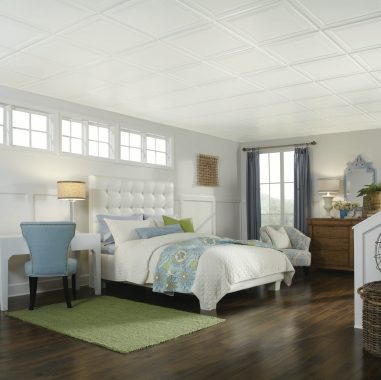Topics
- Acoustic (Soundproofing)
- Basement
- Ceilings
- Design & Inspiration
- Moisture Resistance
When picturing a standard basement, do you think of a damp and dingy room with old, dark wood paneling and horrendous drop ceilings? Well, wipe that picture from your mind, and imagine your basement becoming an extension of your home.
Basement Ceiling Myths
1) All basement ceilings are ugly.
Ditch the notion that basement ceilings need to resemble the drop ceiling panels in your old elementary school or corporate office and embrace stylish tiles and planks designed for your home.
For a trendy yet timeless feel, try real metal ceiling tiles designed to look like antique tin. Perfect for home bars, libraries, wine cellars, and game rooms, these panels will make your basement uniquely memorable. Add warmth with cooper or brass, enhance the feel of openness with white, or add a touch of cool elegance with chrome or lacquered steel. Coordinating grid kits, are available in these finishes that contain everything you need to install 64 sq. ft. of ceiling. Panels are sold separately.
If you’re in love with a farmhouse feel, like log cabin or coastal vibes, or just want to add an element of nature or visual interest, check out painted or natural wood look ceiling planks. They can even be installed over an old 15/16” ceiling grid, completely covering it!
2) Basement ceilings only come in 24” x 48” panels.
Wrong. Today’s ceiling panels come in stunning 24” x 24” panels, and installation is as easy as adding cross tees to your grid. With striking decorative patterns and visually pleasing architectural elements, you can transform your basement into the comfortable, fashionable space you deserve. Wood look planks are another option that can be installed directly over the exisiting ceiling grid, using special clips, completely covering it.
For a simple but impactful update to your existing, dingy 24” x 48” ceiling, try a Smooth Look panel in the same size. Choose a clean and crisp all white panel designed to look like modern 24” x 24” or 12” x 12” tiles.
3) Ceilings take up valuable headroom.
With new advances in installation methods, many drop ceilings only need 3” of hanging space below the joists. Note, you may need to go lower depending on lighting and other obstructions. If you can’t afford any extra headroom, check out surface mount basement ceiling options that can be installed using tracks and clips or directly to joists.
4) Basement ceilings get moldy and sag.
Controlling the humidity in the basement can be difficult and unfortunately, drywall is just as susceptible to moisture as other types of ceilings. Moisture causes problems such as mold and mildew damage as well as staining and sagging. Many of the new ceiling panels are treated to be mold, mildew, and sag resistant. Who wouldn’t want to inhibit the growth of mold, fight stain-causing bacteria, and hinder the presence of moisture-related odors?
An added benefit of these basement ceiling options is that they can also help control noise – reducing distracting echoes, masking sound, and helping stop it from travelling to other parts of your home.
Bonus Myth: A basement ceiling doesn’t make a difference.
Actually, a basement ceiling makes all the difference! Carrying your personal design style down to basement allows your home to feel like one cohesive unit. You can transform your basement quickly and easily from dark and dull to light and refreshing. You can incorporate drama, elegance, or rustic charm and enhance the feel of coziness or create an illusion of more space. Finishing a basement, including the ceiling, also adds value to your home – so not only will you enjoy it, but potential home buyers will too.
Check out our QUICKHANG Grid Hooks
A fast, easy way to install and level a basement ceiling. Save headroom – only 2.5” of drop needed! Great for DIY projects.
Learn More








